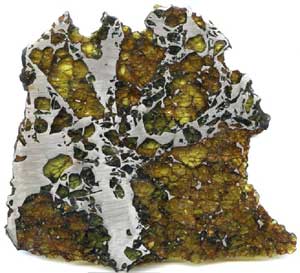A new analysis of crystals in pallasite meteorites suggests that they had a violent birth — but one quite different than scientists had imagined.
Earth’s most beautiful meteorites may have formed in some of the solar system’s most violent collisions, according to a new study published in this week’s issue of Science.

A slice of the Esquel meteorite reveals the glassy green olivine embedded in its iron-nickel matrix. Researchers teased out magnetic signatures in olivine samples from Esquel and another meteorite to reveal the nature of the meteorites' parent body.
Arlene Schlazer
The study examined pallasites — iron-nickel meteorites that trap giant green crystals to form assemblages like stained-glass windows — and concluded that these rare meteorites formed when an asteroid obliterated itself by crashing into a tiny planet in the earliest days of the solar system.
Iron-nickel meteorites are special to begin with. Made of pure metal, these meteorites formed about 4.6 billion years ago, when planets and asteroids were scooping up dust and metal from the debris disk swirling around the newly-formed Sun. This was a violent process — you can’t stick two rocks together with just a little shove — and, as each young planet grew, it melted from the heat of the impacts. The densest elements sank to the center of the melted planet, forming a metallic core. Later, catastrophic collisions between these bodies blasted them apart, shattering the iron-nickel cores into pieces that would eventually land on Earth and be picked up by us.
Pallasites are a rare type of iron-nickel meteorite. The metal from the parent body’s core is mixed with large crystals of the translucent green mineral olivine. Because olivine is the dominant mineral in Earth’s mantle — the layer between the core and crust — planetary scientists thought for decades that pallasites represented the boundary layer between an asteroid’s core and mantle.
Now, a team led by John Tarduno (University of Rochester) has found that the olivine crystals in two pallasite meteorites are magnetized, meaning that the metallic grains inside them aligned with each other in the presence of a strong magnetic field. One meteorite’s surrounding field was comparable to that at Earth’s surface, and the second’s was larger; although both are weaker than the field calculated to exist at our planet’s core-mantle boundary, the intensities do suggest an internally generated magnetic field.
Olivine can only magnetize at low temperatures, and an asteroid’s core-mantle boundary can exceed 900° C, which is far too hot. Tarduno and his colleagues concluded that pallasite olivine must have formed far from the core-mantle boundary, in the top 60% or so of the mantle.
If this is true, it means the body that gave birth to the pallasites wasn’t just broken into pieces by the impact — it was obliterated when it slammed into the protoplanet. The force of the impactor had to be so strong that it injected molten metal from its own core into the protoplanet’s mantle, trapping olivine crystals in a suspended iron matrix.
The new pallasite findings also point to a new perspective on planetary magnetism. The magnetic field that surrounded the forming olivine crystals was likely created by the convection of liquid metal in the core of the original protoplanet. Tarduno’s team estimates that that body was probably just 400 km across – one-eighth the size of the Moon. If true, this would be smallest known planetary body to produce its own magnetic field.
Magnetic fields are critical to the development of planetary environments. All four terrestrial planets once had strong magnetic fields, though Venus and Mars lost theirs at some point. Researchers now think that the early loss of Mars’ magnetic field caused the catastrophic climate change that transformed the planet into a dry, cold world. The new finding could influence how geologists interpret minerals on large asteroids in the future and our understanding of what the solar system's primordial bodies were like.
Guest blogger Selby Cull is a planetary geologist at Bryn Mawr College and studies the mineralogy and geochemistry of the Martian surface. She is also a former intern at Sky & Telescope.
 0
0
Comments
You must be logged in to post a comment.